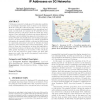Free Online Productivity Tools
i2Speak
i2Symbol
i2OCR
iTex2Img
iWeb2Print
iWeb2Shot
i2Type
iPdf2Split
iPdf2Merge
i2Bopomofo
i2Arabic
i2Style
i2Image
i2PDF
iLatex2Rtf
Sci2ools
IMC
2009
ACM
2009
ACM
Where's that phone?: geolocating IP addresses on 3G networks
Cell phones connected to high-speed 3G networks constitute an increasingly important class of clients on the Internet. From the viewpoint of the servers they connect to, such devices are virtually indistinguishable from conventional endhosts. In this study, we examine the IP addresses seen by Internet servers for cell phone clients and make two observations. First, individual cell phones can expose different IP addresses to servers within time spans of a few minutes, rendering IP-based user identification and blocking inadequate. Second, cell phone IP addresses do not embed geographical information at reasonable fidelity, reducing the effectiveness of commercial geolocation tools used by websites for fraud detection, server selection and content customization. In addition to these two observations, we show that applicationlevel latencies between cell phones and Internet servers can differ greatly depending on the location of the cell phone, but do not vary much at a given locatio...
| Added | 28 May 2010 |
| Updated | 28 May 2010 |
| Type | Conference |
| Year | 2009 |
| Where | IMC |
| Authors | Mahesh Balakrishnan, Iqbal Mohomed, Venugopalan Ramasubramanian |
Comments (0)

